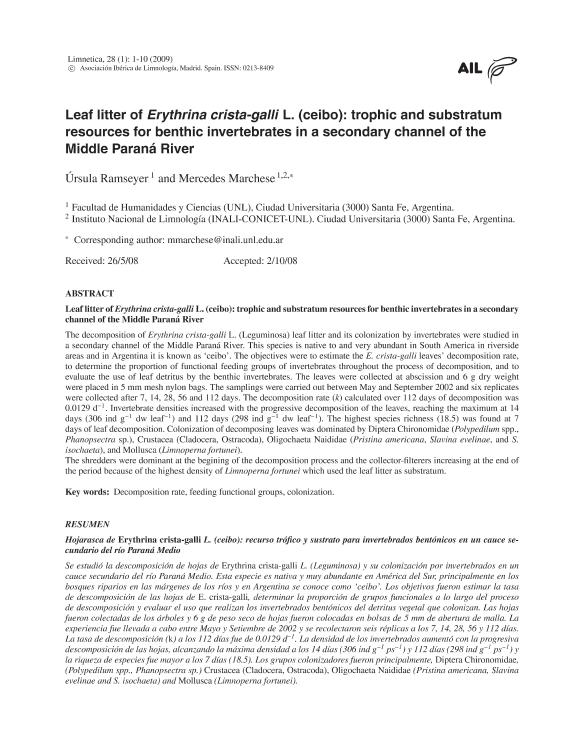Mostrar el registro sencillo del ítem
dc.contributor.author
Ramseyer, Ursula
dc.contributor.author
Marchese Garello, Mercedes Rosa

dc.date.available
2020-04-22T22:23:40Z
dc.date.issued
2009-12
dc.identifier.citation
Ramseyer, Ursula; Marchese Garello, Mercedes Rosa; Leaf litter of Erythrina crista-galli L. (ceibo): trophic and substratum resources for benthic invertebrates in a secondary channel of the Middle Paraná River.; Asociación Ibérica de Limnología; Limnetica; 28; 12-2009; 1-10
dc.identifier.issn
0213-8409
dc.identifier.uri
http://hdl.handle.net/11336/103390
dc.description.abstract
The decomposition of Erythrina crista-galli L. (Leguminosa) leaf litter and its colonization by invertebrates were studied in a secondary channel of the Middle Paran´a River. This species is native to and very abundant in South America in riverside areas and in Argentina it is known as ‘ceibo’. The objectives were to estimate the E. crista-galli leaves’ decomposition rate, to determine the proportion of functional feeding groups of invertebrates throughout the process of decomposition, and to evaluate the use of leaf detritus by the benthic invertebrates. The leaves were collected at abscission and 6 g dry weight were placed in 5 mm mesh nylon bags. The samplings were carried out between May and September 2002 and six replicates were collected after 7, 14, 28, 56 and 112 days. The decomposition rate (k) calculated over 112 days of decomposition was 0.0129 d−1. Invertebrate densities increased with the progressive decomposition of the leaves, reaching the maximum at 14 days (306 ind g−1 dw leaf−1) and 112 days (298 ind g−1 dw leaf−1). The highest species richness (18.5) was found at 7 days of leaf decomposition. Colonization of decomposing leaves was dominated by Diptera Chironomidae (Polypedilum spp., Phanopsectra sp.), Crustacea (Cladocera, Ostracoda), Oligochaeta Naididae (Pristina americana, Slavina evelinae, and S. isochaeta), and Mollusca (Limnoperna fortunei). The shredders were dominant at the begining of the decomposition process and the collector-filterers increasing at the end of the period because of the highest density of Limnoperna fortunei which used the leaf litter as substratum.Limnoperna fortunei which used the leaf litter as substratum.
dc.format
application/pdf
dc.language.iso
eng
dc.publisher
Asociación Ibérica de Limnología
dc.rights
info:eu-repo/semantics/openAccess
dc.rights.uri
https://creativecommons.org/licenses/by-nc-sa/2.5/ar/
dc.subject
DECOMPOSITION RATE
dc.subject
FEEDING FUNCTIONAL GROUP
dc.subject
COLONIZATION
dc.subject.classification
Ecología

dc.subject.classification
Ciencias Biológicas

dc.subject.classification
CIENCIAS NATURALES Y EXACTAS

dc.title
Leaf litter of Erythrina crista-galli L. (ceibo): trophic and substratum resources for benthic invertebrates in a secondary channel of the Middle Paraná River.
dc.type
info:eu-repo/semantics/article
dc.type
info:ar-repo/semantics/artículo
dc.type
info:eu-repo/semantics/publishedVersion
dc.date.updated
2020-04-21T15:25:09Z
dc.journal.volume
28
dc.journal.pagination
1-10
dc.journal.pais
España

dc.journal.ciudad
Barcelona
dc.description.fil
Fil: Ramseyer, Ursula. Universidad Nacional del Litoral; Argentina
dc.description.fil
Fil: Marchese Garello, Mercedes Rosa. Consejo Nacional de Investigaciones Científicas y Técnicas. Centro Científico Tecnológico Conicet - Santa Fe. Instituto Nacional de Limnología. Universidad Nacional del Litoral. Instituto Nacional de Limnología; Argentina
dc.journal.title
Limnetica
dc.relation.alternativeid
info:eu-repo/semantics/altIdentifier/url/https://www.limnetica.com/es/limnetica
Archivos asociados
